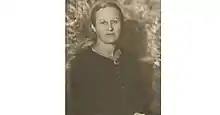Regina Lilientalowa
Regina Lilientalowa (née Gitla Eiger; 14 June 1875 (or 1877), Zawichost — 4 December 1924, Warsaw) was a Polish ethnographer, translator and journalist of Jewish origin. She is known for her pioneering research on Jewish folk rituals and literature.
Regina Lilientalowa | |
|---|---|
 | |
| Born | Gitla Eiger 14 June 1875 |
| Died | 4 December 1924 (aged 49) |
| Citizenship | Polish |
| Occupation | Ethnographer, folklorist, translator |
| Children | Stanisława Nikodym |
Life
Gitla Eiger was born to Moses and Fajga Blum, in a family of Polonized Jews, in Zawichost, at the time a part of the Russian Empire.[1][2] Her year of birth has been variously given as 1875 or 1877.[3] She attended school at Sandomierz. After marriage in 1895 to Nathan Liliental, she moved to Warsaw.[4][3]
Lilientalowa had two children, Stanisława (born 1897) and Antoni (born 1908).[3] Stanisława became a mathematician,[5] while Antoni joined the Polish army and was murdered in the Katyn Massacre.[6]
In later life, Lilientalowa suffered from a progressive lung disease. She died on 4 December 1924 from a failed operation in Warsaw.[4]
Career
In Warsaw, Lilientalowa wanted to pursue higher studies, which was difficult for women, especially those from a Jewish background. To earn a living, she became a history teacher at Polish-Jewish secondary schools.[3]
She began to educate herself privately in Jewish folklore, supplementing her studies by attending the so-called Flying University, which organised courses for women in secret. Under Ludwik Krzywicki, she expanded her knowledge of Jewish rituals and folk literature, and began to publish in Poland's main journals of anthropology, Wisła and Lud.[4]
Lilientalowa published her first ethnographic works Przesady żydowskie (Jewish superstitions, 1898); Zaręczyny i wesele żydowskie (Jewish betrothal and wedding, 1900); Wierzenia, przesady i praktyki ludu żydowskiego (Beliefs, Superstitions and Practices of the Jews, 1904–1905).[4]
Her focus shifted from contemporary Jewish culture to historical customs and rituals, which she studied from German and Russian translations as well as the Yiddish Talmud. She later learned Hebrew and Aramaic to delve deeper into Talmudic traditions, resulting in two well-received books, Dziecko żydowskie (The Jewish Child, 1904), and Święta żydowskie w przeszłości i terazniejszości (Jewish Holidays, in the Past and Present, 1909—1918). Her work included considerable material from field investigations in Lublin, Zawichost, and Radomski, using which she demonstrated the evolution of the rites of the main Jewish pilgrimage days (Pesach, Sabbath and Sukkoth), the religious holidays of Rosh Hashanah and Yom Kippur, and Hanukkah and Purim, which she linked to events associated with nature.[4]
Lilientalowa's interest in Jewish folklore led her to translate I. L. Peretz's Yiddish stories into the Polish language. These were published between 1906–1910. She translated Yiddish folk songs from the collections of Saul Ginzberg and Peter Marek.[4] She also published her translations of women's tkhines prayers, focusing on their moral, magical and healing properties.[7]
Selected works
- "Przesądy żydowskie". Wisła. XII: 277–284. 1898.
- "Przesądy żydowskie". Wisła. XIV: 369–644. 1900.
- "Wierzenia, przesądy i praktyki ludu żydowskiego" [Beliefs, superstitions and practices of the Jewish people]. Wisła. XIX: 148–176. 1905.
- "Kult ciał niebieskich u starożytnych Hebrajczyków i szczątki tego kultu u współczesnego ludu żydowskiego" [The cult of heavenly bodies among ancient Hebrews]. Archiwum Nauk Antropologicznych. I (6). 1921.
- "Ajn-hore". Jidisze Filologie. 4–6: 245–271. 1924.
- Dziecko żydowskie. Warsaw: Midrasz. 2007.
References
- Liliental, Witold (2015–2016). "Dopiero po latach w pełni ją doceniam". Etnografia Nowa (in Polish). Państwowe Muzeum Etnograficzne w Warszawie (7–8). ISSN 2080-8747.
- Liliental, Dorota (2015–2016). "Moja prababka, ambasadorka sztetla". Etnografia Nowa (in Polish). Państwowe Muzeum Etnograficzne w Warszawie (7–8). ISSN 2080-8747.
- Król, Aleksandra. "Regina Lilientalowa – the researcher of shtetl folklore". POLIN Museum of the History of Polish Jews. Retrieved 30 April 2020.
- Bieńkowski, Wiesław (1972). "Regina Lilientalowa (z domu Eiger)". Polish Biographical Dictionary (in Polish). Retrieved 30 April 2020.
- Ciesielska, Danuta (2018). "A mathematician and a painter Stanisława Nikodym and her husband Otton Nikodym" (PDF). In Kjeldsen, T.H.; Oswald, N.; Tobies, R. (eds.). Women in Mathematics: Historical and Modern Perspectives. Mathematisches Forschungsinstitut Oberwolfach. doi:10.4171/OWR/2017/2.
- The Katyn Forest Massacre: Hearings Before the Select Committee to Conduct an Investigation of the Facts, Evidence and Circumstances of the Katyn Forest Massacre, Eighty-second Congress, First-[second] Session, on Investigation of the Murder of Thousands of Polish Officers in the Katyn Forest Near Smolensk, Russia, Parts 1-4. U.S. Government Printing Office. 1952. p. 100.
- Jakimyszyn-Gadocha, Anna (2015–2016). "Modlitwy dla kobiet (tchines) i ich obecność w piśmiennictwie etnografów (folklorystów) żydowskich przed 1939 rokiem". Etnografia Nowa (in Polish) (7–8).